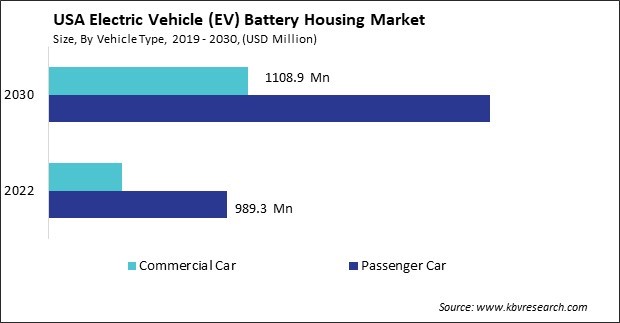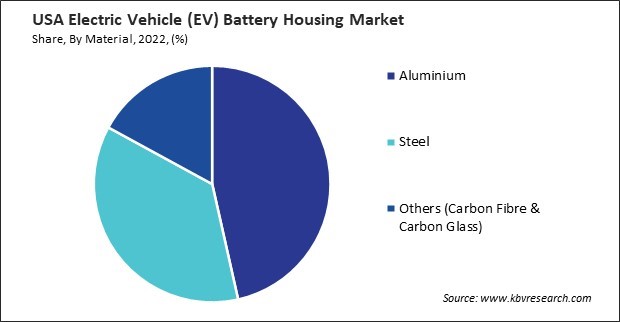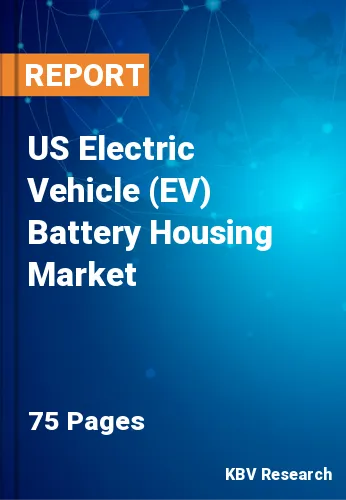The USA Electric Vehicle (EV) Battery Housing Market size is expected to reach $3.6 billion by 2030, rising at a market growth of 12.1% CAGR during the forecast period.
The electric vehicle (EV) battery housing market in the United States is experiencing significant growth driven by the increasing adoption of electric vehicles. The surge in electric vehicle production is propelling the demand for E.V. battery housing as automakers invest in electric mobility to meet regulatory requirements and consumer demand for more sustainable transportation options.

The involvement of major automakers and tech companies has accelerated the expansion of the EV supply chain. Companies like Tesla, General Motors, Ford, and others have made significant investments in electric vehicle production and technology, spurring innovation and competition in the industry. This involvement has increased the availability of electric vehicles and contributed to the development of a robust supply chain to support their production.
The COVID-19 pandemic notably impacted the demand for EVs in the US. While the pandemic initially led to a slowdown in car sales due to economic uncertainty and lockdown measures, the subsequent recovery has seen a surge in demand as consumers seek out private transportation options that offer safety and flexibility in the face of public health concerns.
Corporate Average Fuel Economy (CAFE) standards, set by the National Highway Traffic Safety Administration (NHTSA), require automakers to meet specific fuel economy targets for their fleets. By encouraging the production of fuel-efficient vehicles, CAFE standards indirectly promote the adoption of EVs by making them a more attractive option for customers seeking to reduce their fuel consumption. Thus, the EV battery housing market in the US is poised for continued growth as the demand for electric vehicles continues to rise.
According to the United States International Trade Commission, since 2017, the quantity and variety of EVs produced and sold has expanded rapidly. Global EV sales increased 78 percent from over 754,000 in 2017 to over 1.5 million in 2019. U.S. EV sales doubled from 104,490 in 2017 to nearly 245,000 in 2019. With Tesla's Model 3 selling at such high volumes, U.S. production has a higher share of U.S. EV sales than in previous years. In 2017, 13 different EV models were offered in the United States, but in 2019, that number expanded to 18. Therefore, in conjunction with this surge in EV adoption, the electric vehicle (EV) battery housing market in the United States is poised for significant growth, reflecting the escalating demand for EVs and their components.
The United States government has implemented various forms of support to promote the adoption and expansion of electric vehicles (EVs) to reduce greenhouse gas emissions, improve air quality, and advance sustainable transportation. These initiatives encompass a range of policies, incentives, funding programs, and regulatory measures to accelerate the transition to electric mobility.
One of the key forms of government support for EVs in the US has been the implementation of federal tax credits for consumers who purchase qualifying plug-in electric vehicles. These tax credits, which can amount to several thousand dollars, are designed to reduce the upfront cost of EVs and make them more financially appealing to consumers. By incentivizing EV purchases, the government aims to spur demand and facilitate the adoption of cleaner transportation options.
Moreover, the US government has promoted the use of EVs in its fleets and provided incentives for state and local governments to adopt EVs. By leading by example and providing financial incentives, the government aims to demonstrate its commitment to sustainable transportation and encourage broader adoption of EVs nationwide. Consequently, as the EV industry grows, the demand for EV battery housing will remain strong, presenting opportunities for manufacturers and suppliers in this segment.
The demand for passenger cars in the United States has shown resilience and growth in recent years. One significant factor is the country's strong economic performance, which has led to increased consumer confidence and spending. As disposable incomes have risen and unemployment rates have fallen, more consumers have felt financially secure enough to make big-ticket purchases like cars, leading to a rise in demand for passenger vehicles.
Another factor contributing to the increasing demand for passenger cars in the US is the availability of attractive financing options. Low-interest rates and favorable lending terms offered by banks and financial institutions have made it easier for consumers to finance car purchases, encouraging more people to buy new vehicles. Additionally, leasing options have become popular, providing consumers with flexibility and affordability, further boosting car sales.
The increasing demand for passenger cars in the United States has notably impacted the demand for electric vehicle (EV) battery housing, driven by the growing popularity of electric and hybrid vehicles within the broader automotive industry. As more consumers opt for passenger cars, including electric and hybrid models, the demand for EV battery housing has surged in response to the need for components that support the production and operation of these vehicles.

The US electric vehicle (EV) battery housing market is characterized by several key companies that play significant roles in developing, manufacturing, and supplying battery housing solutions for electric vehicles. These companies are at the forefront of innovation in the EV battery housing segment. They are actively contributing to the growth and advancement of the electric mobility industry in the US.
Tesla is a leading electric vehicle manufacturer known for focusing on sustainable energy solutions. The company is a major player in the EV battery housing market, as it designs and manufactures its battery packs, including the housing components, for its electric vehicles. Tesla's expertise in battery technology and manufacturing has positioned it as a key player in the EV industry, strongly emphasizing performance, range, and safety.
As one of the largest automakers in the world, GM has been actively investing in electric vehicle technology and is a major player in the US EV battery housing market. The company has made significant strides in EV development through its Chevrolet Bolt EV and upcoming electric models under the Cadillac brand. GM's commitment to electrification has led to advancements in battery housing technology and manufacturing processes.
Panasonic is another key player in the electric vehicle (EV) battery housing market, known for its collaboration with Tesla in producing battery cells and modules for Tesla's electric vehicles. The company's battery technology and manufacturing expertise have contributed to developing robust and efficient battery housing solutions for electric vehicles.
Beyond automotive manufacturers, specialized companies focus specifically on battery technology and components for electric vehicles. These companies, such as LG Energy Solution, Panasonic, and Samsung SDI, are global leaders in battery cell production and supply. While not based solely in the US, these companies have a significant presence in the country's EV battery housing market through partnerships and supply agreements with domestic automakers and battery system integrators.
Overall, the US electric vehicle (EV) battery housing market is characterized by a mix of established automotive manufacturers, specialized battery suppliers, and technology-driven companies collectively driving innovation and growth in the electric vehicle industry. These companies are instrumental in shaping the future of electric mobility and developing sustainable transportation solutions in the US and beyond.
By Vehicle Type
By Material
Our team of dedicated experts can provide you with attractive expansion opportunities for your business.

